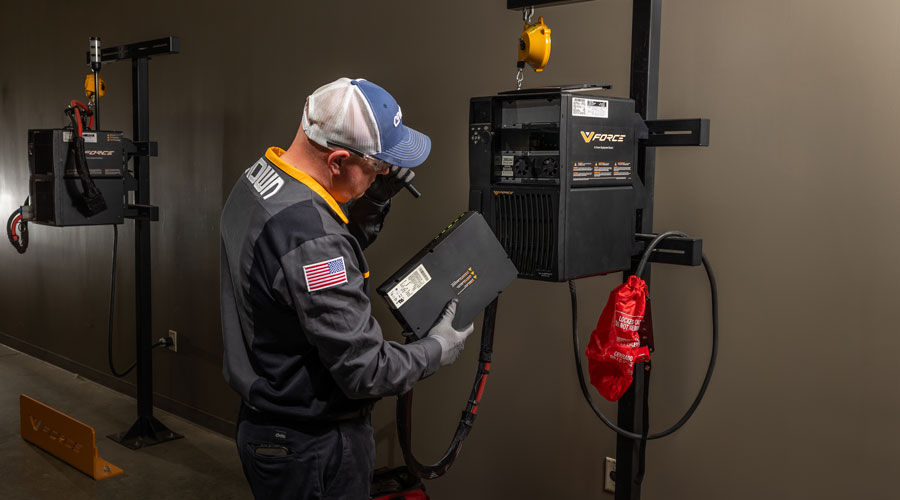Preserving Forklift Power: It’s All About the Batteries

When it comes to electric forklifts, what could be more important than the power that moves them? If batteries aren’t healthy and ready to perform, your equipment is essentially non-functional. Yet, while you’ll find that many companies recognize the importance of planned maintenance for their material handling equipment, a much smaller percentage exercises the same care for the batteries that power their forklift fleet. This blog discusses how to preserve your power source with proper battery maintenance and help ensure that your forklift fleet is ready to perform when needed.
Think about the number of times that you’ve experienced downtime associated with your forklift batteries. Perhaps it was a bad cell or maybe an inner cell connector. Maybe the battery simply could no longer hold a charge. Other battery-related issues, such as a failed battery charger or a broken charging connector, can also compromise the performance of a forklift, or even keep it from performing altogether. Your batteries and chargers provide the lifeblood of your electric forklifts – the heart of your forklift fleet – so a planned maintenance program focused on these valuable resources makes a lot of sense.
Let’s Start with the Battery
There are many facets to proper battery and charger maintenance. The technician usually begins with a visual inspection of the battery housing, filler caps and connectors, looking for any sign of leakage or corrosion. The top and exterior is wiped down with a solution to neutralize the effects of battery acid. The technician then checks cell voltages and records specific gravity readings, noting any abnormalities that could prevent the battery from performing as it should. These anomalies, while they may not prevent operation at the time, will be tracked over time so a deteriorating condition can be identified and addressed before they create a work stoppage.
Unattended or neglected batteries potentially affect the safety of your operators and those around them, as they can be prone to leakage, swelling and, on rare occasions, may even have the potential to explode. When you have battery and charger maintenance in place, the likelihood of unexpected battery failures diminishes because physical damage and corrosion can be identified sooner than later. Well-maintained batteries are also more energy efficient, which may result in lower energy bills and fewer battery replacements.
Beyond the Battery: Crown’s Inclusive Maintenance Strategy
While completing charger planned maintenance, technicians will clean and inspect the charger and connectors for damage and clean or replace the charger’s air filter when needed. Dirty air filters can cause chargers to build up and retain heat, which can reduce output and result in longer charge times or even no charge at all.
Beyond cleaning, inspecting and documenting the status of your batteries and chargers, Crown service technicians can assist you with proper charging to battery sizing recommendations, showcase proper cable management practices, and check connector and contact tip conditions.
Leading the Charge Toward Proper Charging
Once the proper measures are in place to help ensure battery integrity, it’s time to consider how charging can affect battery health. A healthy, well-charged battery is crucial to the performance of your equipment, and proper charging, including a weekly equalization charge, is one of the most important contributors to a battery’s performance and longevity.
Improper charging can cause sulfation to form on the battery plates. As it builds up over time, it can cause irreversible damage to a battery cell or an entire battery. A charged battery also loses energy over time, even when it isn’t in use. A regularly scheduled charge, even for stored batteries, can help them retain and maintain a higher state of charge so they are ready to perform when you need them most.
Battery Watering: The Core of Traditional Battery Care
In operations with wet-cell batteries, most anyone will tell you that the most challenging part of battery care is keeping each battery cell properly watered. It can be messy, time consuming and tedious. However, improper watering is the primary cause of premature battery failure and replacement. Consequently, in addition to a disciplined charging schedule, it is equally important to maintain a disciplined watering schedule that ensures that each battery maintains its recommended capacity as long as possible.
Thankfully, there are battery care options available that can help streamline the watering process. Some of these options connect directly to the battery, with a system of hoses and filler valves that enable single connection watering for a multi-cell battery. These systems will also automatically fill the cell to the correct level without having to check each cell individually. For a large operation, these systems can help save time and simplify service labor requirements, but they can also pay for themselves many times over in extending battery life and reducing replacement expenses.
The Promise of New Power Technologies
While traditional lead-acid batteries have been and continue to be the backbone of the electric forklift industry, there are other battery technologies, such as lithium-ion, that are now available and may be a better power solution for some applications. While sealed lithium-ion batteries don’t require the same level of attention as lead-acid batteries, one cannot think of them as requiring no up-keep. Charger maintenance, proper charging schedules and procedures and cable management are all still important factors in extending lithium-ion battery life and increasing productivity.
In a fully integrated power system, all the components are designed to work together as a complete system. No matter which power solution you choose, an integrated system deserves an inclusive, proactive approach to forklift, charger and battery maintenance to help extend product lifespan, reduce costs and increase reliability.
Be sure to subscribe to the Crown blog for more tips, advice and the latest in all things related to material handling. To learn more about the importance of complete forklift maintenance and service, download Crown’s Service and Maintenance e-book.